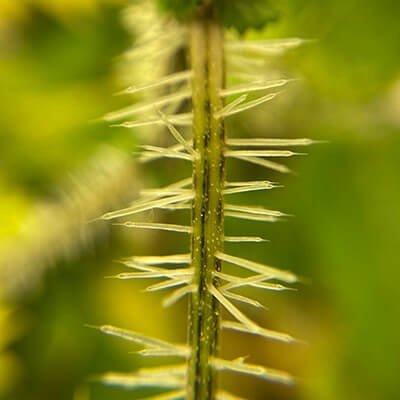Researchers at the IMB’s Centre for Pain Research have found that a native New Zealand stinging tree produces toxins that could hold clues for future pain medication.
In a quest to find new molecules that affect pain pathways, Dr Thomas Durek, Dr Sam Robinson, Dr Edward Gilding and Ms Jing Xie studied toxins from the tree nettle known as ongaonga, one of New Zealand’s most poisonous plants that can cause painful stings that last for days, and in severe cases can even be lethal.
The team had previously investigated toxins found in an Australian gympie-gympie stinging tree but found the New Zealand tree nettle toxins activated pain receptors in a new way.
https://youtu.be/YcJiPrb0uPM
Sharing family with the Australian stinging tree
“We discovered that the New Zealand nettle tree toxins target the same receptor as their Australian counterparts, but they cause pain in a different way,” Dr Robinson said.
“The Australian stinging tree and New Zealand tree nettle are both members of the nettle family, but separated millions of years ago and have evolved differently.
“The New Zealand tree nettle can grow up to four metres tall and its leaves and stems are covered with stinging hairs that pierce the skin and deliver venom which causes long-lasting pain.”
Toxin evolved to fend off the Moa
“Fossil remains show that the large flightless bird, the Moa, had a liking for eating the tree nettle and it’s likely the strong toxins evolved to fend off the now-extinct bird.”
The team faced challenges during the study with international COVID travel restrictions, but they made it work.
“COVID has not made it easy to source nettles, because the easiest way to get them is to travel to other countries and collect the plants.”
“To keep our research going through the pandemic, we managed to source seeds from the New Zealand tree nettle and grow the plant under quarantine in the lab.”
Finding new ways to treat chronic pain
Professor Irina Vetter Director of IMB’s Centre for Pain Research, said understanding pain pathways was key to finding new ways to treat chronic pain.
“Animal venoms have been studied for decades but plants have evolved toxins differently, and this gives us a chance to find molecules that work in a unique way,” Professor Vetter said.
“Our goal is to tackle pain more effectively without side effects and addiction.”
Plants have evolved toxins differently
With travel bans lifting, sting connoisseur Dr Gilding plans to go to Vietnam later this year to experience “anything that stings” and is applying for funding to also visit Madagascar and South America to widen the net.
“There are several hundred nettles in the Urticaceae family with stinging hairs around the world — we’re keen to compare how they have evolved and whether they all use the same toxins,” Dr Gilding said.
This research is published in the Journal of Biological Chemistry and was funded by organisations including the Australian Research Council and the National Health and Medical Research Council.

